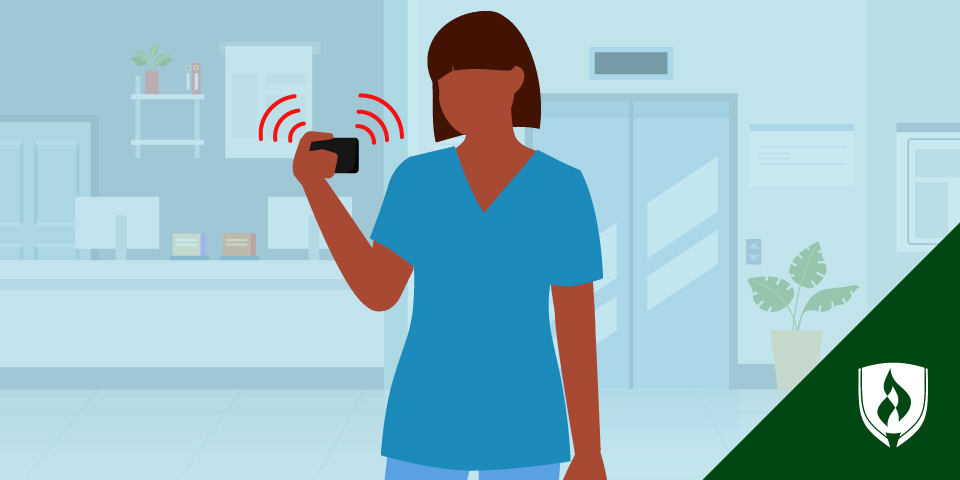What Is a Rapid Response Nurse? A Closer Look at These Ready Responders
By Kirsten Slyter on 05/16/2023

There’s no question that a critical care environment can be exciting. Most nurses interested in caring for the sickest patients find themselves suited for the intensive care unit (ICU) or emergency medicine (ER).
Generally speaking, ICU nurses lean toward a more orderly environment, while ER nurses embrace the organized chaos of their unit. But what if you find yourself solidly in the middle? Or maybe you have enough experience in one to wonder what other critical care options might be a good fit for you.
Either way, it’s worth exploring the world of rapid response nursing. This role can be a good option for personalities that find themselves torn between the ER and the ICU. We’re here to give you a boost in your rapid response nursing knowledge with the help of Sarah Lorenzini, MSN, RN, CCRN, CEN—the host of the Rapid Response RN podcast.
What is a rapid response?
Before we get started, it’s worth noting that the term “rapid response nursing” is often used to describe both rapid response travel nurses, who take assignments on short notice, and a nurse on a hospital’s rapid response team. Here, we’ll be walking through what it’s like to work as a nurse on a rapid response team in a hospital.
If you’re more interested in learning about travel nursing, check out our article “Pros and Cons of Being a Travel Nurse: Expert Insight for New Nurses.”
A rapid response (or just “rapid”) in a hospital setting is an alert that notifies the rapid response team, also called the medical emergency team at some hospitals, of a patient experiencing critical changes to their health status. This is often the quickest way to get clinicians with critical care expertise to the bedside. A rapid response might be called for changes like the following:
- Heart rate changes to over 140 beats per minute (bpm) or less than 40 bpm
- Systolic blood pressure greater than 180 mm Hg or less than 90 mm Hg
- Blood oxygen saturation less than 90 percent despite supplementation
- Acute change in mental status
- New uncontrolled pain
- Chest pain
- Seizure
Of course, this is just a sampling of concerning trigger conditions that may require a rapid response. A rapid response can include any significant concern a healthcare team member has for a patient.
The rapid response team is usually made up of critical care nurses and, depending on the provider or availability, a respiratory therapist. Not every hospital has a dedicated rapid response team. In some hospitals, the ICU charge nurse responds to any rapid responses called. While their expertise is clearly valuable for getting a patient’s status stabilized as soon as possible, this approach has the downside of moving an important resource away from a unit that may already be stretched thin.
Dedicated rapid response teams have been shown to improve patient outcomes. According to Lorenzini, when the rapid response team at her hospital was implemented, the number of code blues was cut in half in the team’s first year.
She credits this to the fact that the number of rapid responses called tripled in that same year. By intervening early, she estimates many codes were prevented. “That’s what I love about this role. We’re not just responding to emergencies, but preventing them,” says Lorenzini.
What does a rapid response nurse do?
Rapid response nurses are the core of any rapid response team. Responding to emergencies and providing education are the two biggest parts of a rapid response nurse’s job.
Lorenzini starts her day by getting a report from the previous shift, where they’ll discuss any patients she should keep her eye on. She then pulls the Modified Early Warning Score (MEWS) from the electronic health system, which flags patients who may be at risk of decompensating. From there, she starts making her rounds throughout the hospital to check in with those high-risk patients and their nurses.
While she would love to be able to get through her whole list of check-ins in a day, that doesn’t always happen, as patient status changes can quickly cause a shift in plans.
She’s responsible for responding to all rapid responses and codes, including those flagging sepsis, STEMI (acute heart attacks), strokes and massive blood transfusions. These happen frequently in a busy hospital, so Lorenzini can be pulled to any part of the building at a moment’s notice.
Her rapid response team also responds to “nurse consults.” These enable nurses on the floor to call for a critical care nurse from the rapid response team to come to the bedside and help prevent a rapid response from needing to be called. This usually happens before the patient’s vitals dramatically change, but the nurse has concerns about how the patient is acting, breathing or simply how they look.
These kinds of consults allow the rapid response nurse to help narrow down what’s going on with the patient and partner with the doctor and the patient’s nurse to figure out what can be done to prevent the patient from getting worse. They are also a great opportunity for rapid response nurses to provide education to nurses who may not have had as much critical care experience.
Rapid response nurses also help transport patients to the ICU or surgery if the patient is not stable enough for the floor anymore. “I never walk away from a patient until we find out what’s going on and we know if they’re stable [enough] to stay where they are,” says Lorenzini.
What is rewarding and challenging about rapid response nursing?
Lorenzini loves the role she gets to play as a rapid response nurse in an emergency. “I have the opportunity to show up on everybody’s bad day,” she says.
She takes pride in being able to lower the level of anxiety in the room and bring guidance into the middle of a crisis. Lorenzini says she feels she’s truly making difference for the nurse, the patient and their family.
She’s told often that she “could have been a doctor.” While she acknowledges that medical school was a possibility for her, she loves the role she plays as a nurse. Nurses often spend more time with patients than doctors do. Nurses also take on more hands-on responsibilities where they get to form a relationship with the patient. “I chose a job where my compassion has value. The healing I do uses more than my brain,” Lorenzini says.
One of the most challenging parts of any emergency or critical care nursing job is regulating your emotions during a crisis. It’s natural for the sympathetic nervous system to rev up during an emergency and cue your “fight of flight” response. It’s normal for your breathing to become quick and your hands to shake when experiencing stress.
Instead of feeling those sensations and becoming more nervous, Lorenzini tells other nurses to think of sensations as your body getting ready to act. In fight or flight scenarios, your vision sharpens and your heart rate and blood pressure increase to help you move faster. When this happens, Lorenzini thinks to herself, “I’m about to be the best nurse possible for this patient.”
While addressing your response to stress isn’t easy, if you can do it successfully, you’ll be able to help fellow nurses and your patients stay calm during a crisis.
What makes a good rapid response nurse?
While critical care and emergency medicine may seem glamorous on TV, the best rapid response nurses care about preventing emergencies just as much as addressing an active emergency. “It’s not just about doing CPR and pushing [epinephrine],” says Lorenzini.
The job is just as much about education and empowering other nurses. Her rapid response team rounds with the crash cart and provides brief refreshers on codes to floor nurses. When hiring, Lorenzini looks for nurses who are willing to build up others and lead others well.
“The way we communicate makes a big difference in the patient’s outcomes,” she says.
Part of empowering other nurses means paying attention to “nursing intuition.” This might be a hunch a nurse has about a patient being more ill than their current vitals and test results reflect. Or that a patient is about “crash” even if they look okay at the moment.
While it’s a hard-to-qualify skill, nursing intuition has been studied and found to be more than just a “gut feeling.” It is based on a nurse’s professional experience and knowledge.
“Nursing intuition is the most valuable indicator of patient decline,” says Lorenzini. Her job as a rapid response nurse is to help other nurses break down exactly what they’re observing in their patient and what it might mean when they have that sense about their patient.
The best rapid response nurses can also be a little bit nosy—but in a good way. Lorenzini states she would get chided for being “too nosy” as a kid, but now she prides herself on wanting to know everything that’s going on in the hospital and using it to do better at work. That doesn’t mean being plugged into workplace gossip, however. It means knowing what patients are at risk of decompensating and which nurses or departments might need support throughout a shift.
How to become a rapid response nurse
The first step on the road to becoming a rapid response nurse is to become a registered nurse (RN). To do that, you’ll need to earn a degree—either an Associate's Degree in Nursing (ADN) or a Bachelor of Science in Nursing (BSN)—and meet all other requirements for state licensure, including passing the NCLEX-RN®.
If you are interested in becoming a rapid response nurse, you’ll want to gain experience in the ER or ICU and become a valuable clinician in these settings. Many rapid response team nurses carry either a Critical Care Registered Nurse (CCRN)® or Certified Emergency Nurse (CEN)® certification that boosts their specialty knowledge—and helps showcase credibility on their resume.
Like nurses in other specialties, rapid response nurses use nearly every nursing skill within their scope of practice. Lorenzini says that she loves staying current on specialized skills like:
- Advanced cardiac life support (ACLS)
- Placing intraosseous lines, which provide easy access for medications through a patient’s shin bone in an emergency
- Managing arterial lines—a tube placed into an artery that allows for blood draws and invasive vital monitoring
- Ultrasound-guided intravenous line, which uses an ultrasound machine to help get IV access on a patient with harder-to-find veins
Lorenzini encourages nursing students interested in rapid response nursing to seek out clinicals in emergency medicine or critical care. Or simply shadow a nurse in the ICU or ED if you can’t obtain a clinical placement there.
Is rapid response nursing in your future?
Working as a rapid response is a unique way to apply yourself in a critical care role. Every day, these nurses use their specialized skills and sense of calm in crisis to give seriously ill patients in all parts of the hospital another chance to fight back.
If this sounds like a great fit for you, the first step is to start down the path of becoming a registered nurse. Our article “How to Become a Registered Nurse: A Simple Step-by-Step Guide” lays out a straightforward view of what lies ahead.
NCLEX-RN is a registered trademark of the National Council of State Boards of Nursing, Inc.
CCRN is a registered trademark of AACN Certification Corporation.
Certified Emergency Nurse (CEN) is a registered trademark of the Board of Certification for Emergency Nursing Corporation.




